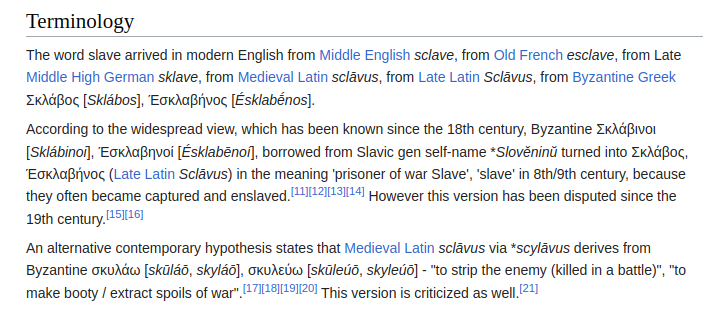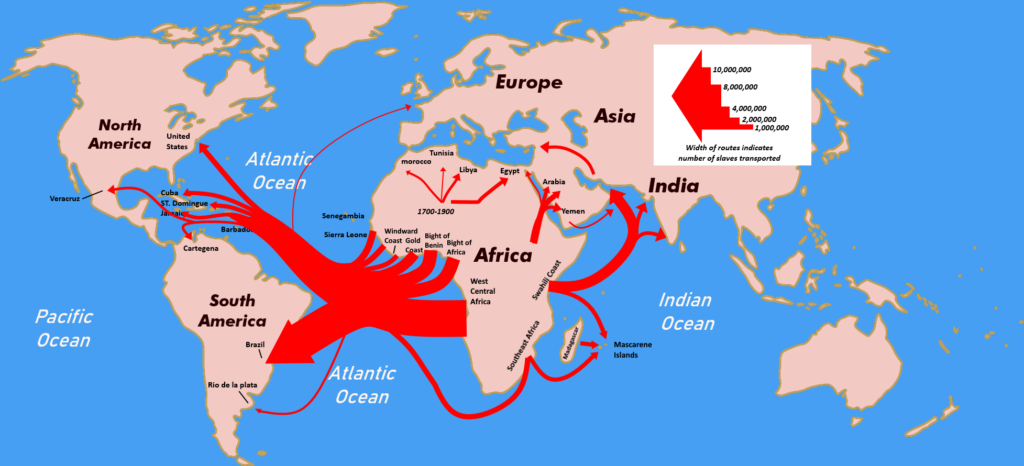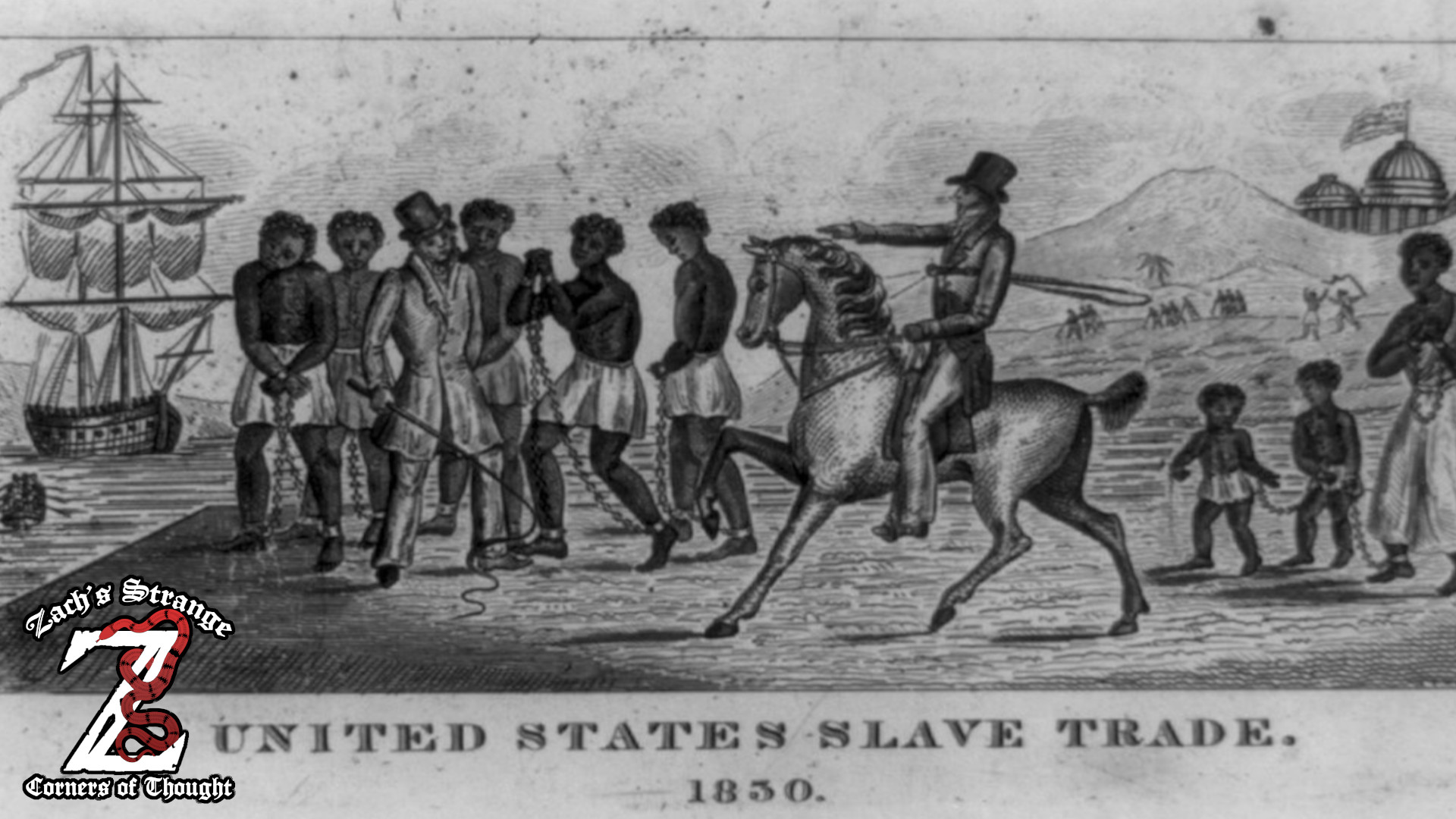04/29/2023
Was U.S. slavery different from other forms of slavery? Some commentators try to minimize the slavery’s impact on the United States. This is a brief history of slavery in the United States.
Citations:
Alexander, Michelle. The New Jim Crow: Mass Incarceration in the Age of Colorblindness, Tenth Anniversary Edition. New Press, 2020. Buy here!
Davis, Adrienne. “‘Don’t Let Nobody Bother Yo’ Principle’: The Sexual Economy of American Slavery.” Sister Circle: Black Women and Work, edited by Sharon Harley, Rutgers University Press, New Brunswick, NJ, 2002. Buy here!
Diouf, Sylviane A. Servants of Allah: African Muslims Enslaved in the Americas. Buy here!
Lewis, Bernard. Race and Slavery in the Middle East: An Historical Enquiry. Oxford University Press, 1992. Buy here!
As an Amazon Associate, I earn from qualifying purchases.
TRANSCRIPT
Today, we’re going to talk about what is arguably the original sin of the United States: slavery. I say arguably because you might have heard some people make comments that seem like an attempt to minimize slavery’s influence in the United States, and minimize the unique characteristics of American slavery that distinguishes it from the others which have existed: race. In the Americas, people were enslaved based exclusively on one’s race, a word that didn’t exist in its modern form as denoting an objective, biological quality prior to the Enlightenment. A word that generally means a form of hierarchical categorization based primarily on skin color, physiognomy, & hair texture.
Before we continue, let’s define what it means to be a slave: A person is enslaved if they are forced to work for and obey another without pay and is considered to be their property. An Enslaved person is often not legally a person at all and has no rights besides those praetermitted by the person who owns or controls them, though different peoples throughout the world treated this question of personhood and civil rights differently. For example, In the Islamic world Enslavers (in theory) were expected to treat their slaves fairly, and an enslaver who was too cruel could, in some cases, be forced to manumitte or free the enslaved. Finally, an enslaved person had no expectation of being manumitted contrary to indentured servitude where the servitude is (in theory) for a fixed time.
BTW, where did this English word slave come from? Etymologically, it’s…. complicated.

Ancient Greek philosopher Aristotle developed the concept of certain people’s being naturally born for slavery, and this theory was used as a justification for slavery since then. Aristotle’s theory of natural slavery didn’t rely on the physiological characteristics associated with race today. It was based more on forms of government, certain virtues, and even language. In general, Ancient Greece viewed all non-Greeks as inferior referring to them as barbarians (barbaros), people who babbled and didn’t speak Greek.
Aristotle thought these virtues were influenced by a climate model, whereby peoples living in more extreme climates lacked certain virtues in contrast to the climate of the Greeks which was just right. This was the dominant form of ethnological theory well into the 18th century. This narrow area of climate-based ethnic superiority had a funny way of moving around depending on who was invoking it.

Prior to the creation of the Trans-Atlantic slave trade, the Arab slave trade was all the rage, going back to the 8th century where the Muslim Arabians conquered parts of three different continents. This include trans-Saharan Africa. While the Quran & Islamic jurisprudence maintained that all races were equal, they fully accepted the practice of slavery, especially for polytheists and non-Muslims. Islamic culture definitely paid more attention to racial differences than the Greeks & Romans, and both culturally & practically the black people of Africa were inferior to other races. Of all the peoples enslaved, Africans made up a majority and were considered the least valuable in comparison to Europeans and Persians. Even linguistically, we already find an equivocation between blackness & slavery, which the Europeans & the Trans-Atlantic Slave trade inherited. In Arabic, there were different words for white slaves & black slaves. White slaves were called mamluk, which means “owned”, while black slaves were called ‘abd. Eventually, ‘abd was often used to describe all black men both free and enslaved. Despite this anti-black racism, the Arab Slave Trade was never based on race. Not only were all races equal legally and theologically, there were always white slaves during the 1200 year period of the Arab Slave trade. I could do a whole video about the Arab Slave Trade, and its relation to a concept of race. Let me know in the comments if that is something you’d like to see, cause it is pretty fascinating.

The Trans-Atlantic Slave trade began around 1500 with the discovery by Europeans of the Americas. During its 400 year reign, between 12.1-12.8 million Africans were kidnapped to the Americas. Another 1.2-2.4 million kidnapped Africans did not survive the Middle Passage to the Americas, and died chained up underneath the decks of ships or thrown overboard into the ocean. European slave traders bought Africans from other Africans and transported them to the Americas, mainly Brazil & the Caribbean.
Throughout history their were three main ways people became enslaved: war, debt, or criminal punishment. It was no different in Africa. Armed conflict in Africa provided the largest contingents of enslaved peoples from West Africa to the Americas. Europeans had a policy of only trading the best goods (guns and powder) for slaves, refusing to trade such items for anything less:
“This policy was firmly applied all along the coast, and it locked the Africans into a terrible vicious circle. If a party acquired superior weapons, its potential rivals would have to do the same to avoid becoming its next victims. This meant getting & selling men, women, & children to secure arms in order to protect one’s population from enslavement. Weapons & ammunition were exclusively sold to the rulers, not the peasants, because the trade companies wanted to ensure that the latter could not defend themselves and thus become easy prey.”
Diouf, Sylviane A. Servants of Allah: African Muslims Enslaved in the Americas.
During the 16th & 17th century, racial concepts like whiteness & blackness were still in their infancy within the realm of Christendom. Categories like “English”, “Spanish”, “Portuguese”, “French”, “Christian”, “Subject”, “foreigner”, “African”, etc. functioned as exclusionary categories similar to the way whiteness & blackness functioned in the 19th-20th centuries. It was the conflict between these categories in the growing colonial & plantation societies that created the racial concepts we know today, as these racial concepts became in many instances a more useful form of social hierarchy that protected the interests of the white, European, capitalist class.
Slavery began in colonial North America in the 17th century, and the English which controlled this area were relative newcomers to the slave trade, in comparison to Portugal & Spain. You might have heard that slavery began in colonial North America in August of 1619…. but this isn’t true. According to Nell Irvin Painter:
“The 20 or so Africans were sold and bought as ‘servants’ for a term of years, and they joined a population consisting largely of European indentured servants, mainly poor people from the British Isles whom the Virginia Company of London had transported and sold into servitude.”
Painter, Nell Irvin. “How We Think about the Term ‘Enslaved’ Matters.” The Guardian, Guardian News and Media, 14 Aug. 2019.
Africans bought and transported across the Atlantic were enslaved if sold in the Caribbean or Brazil, but indentured if brought to North America, at least in the early 17th century. And, this was because the demands of the North American English colonies were fundamentally different than those elsewhere.
This distinction between slaves & indentured servants is not insignificant. Look at the example of an African man from Angola, named Antonio, was sold not into enslavement but into indentured servitude in Jamestown in 1621. In the 1630s, his servitude was over, and he was declared a free negro taking the name Anthony Johnson. Johnson bought his own land & his own indentured servants.
In the 1650s, one of Johnson’s own indentured servants, John Caser, claimed his servitude had expired 7 years prior and Johnson was illegally holding him. Caser later entered into an indentured servant contract with Johnson’s neighbor Robert Parker, but Johnson sued Parker. In 1655, a court ruled in favor of Johnson. It was the first time in the 13 North American colonies that a court ruled that a person who had committed no crime could be held in servitude for life. Both the enslaved person and his “owner” were black.
Yet, this non-racial aspect of slavery wouldn’t last long. Ironically, when Anthony Johnson died fifteen years later in 1670, his land was given to a white colonist, not his children. A judge declared that because Johnson was black, he was not a citizen.
Between the 1660s and the 1680s, Virginia passed laws marking off black Africans as slaves. This marking off of Africans as slaves was done for several reasons.
In 1656, a black woman, Elizabeth Key Grinstead, successfully sued for her and her child’s freedom because her father was a white, Englishman. England had no system for naturalization of foreigners, so people born with one parent, an English subject, and another, a foreigner, caused confusion. English common law granted social status based on pater familias or the father. Grinstead was a practicing Christian whose English father had sold her into indentured servitude for a 7-year period. When her owner refused to release her, she sued and won her freedom.
After this, and other such cases, in 1662 Virginia nipped that problem in the bud. A law was passed saying the status of a child (i.e., their status as a white, English subject or a black foreigner) descended from their mother what is called Partus sequitur ventrem (L. “That which is born follows the womb. If you’re mother was enslaved, then so were you. Partus sequitar ventrem existed for slaves and livestock during Roman times, but the English only applied it to livestock. Englishman were expected to care for their bastard children. When Virginia legalized Partus sequitar ventrem for enslaved people, it freed white Englishman the burden of caring for their illegitimate children with enslaved black women. The father of the enslaved child was legally irrelevant. As Adrienne Davis says, “By American law, the child of an enslaved black mother had no father.”1 In an 1811 case in Kentucky, Frazier vs. Spear, Judge Clark said, “the father of a slave is unknown to our law.” The child of such a union, like the mother it came from, was the property of the slave owner.
As plantations grew. the demand for labor only increased. Native Americans were a poor choice for enslavement, because natives knew the land and could fight back against such attempts. European immigrants were also a poor choice for free labor, not because of their race, but because enslavement would interfere with voluntary emigration from Europe. You wouldn’t willingly come to the colonies if there was a good chance you’d be enslaved.
Africans, on the other hand, made ideal slaves. West Africa was an extremely diverse place with numerous cultural, ethnic, and linguistic differences. But, slave traders rarely cared about such distinctions. “The process of shipping and marketing slaves literally stripped the signs of national difference from the bodies of Africans.” It mattered little to slave traders the ethnic or national origin of the people he sold. “Slavery subjected Africans of diverse cultures, languages, and levels of “civilization” to a uniform system of debasement.”2 Once enslaved in the colonies, these cultural, ethnic, and linguistic differences made it impossible for enslaved people to organize solidarity amongst themselves and resist like the Native Americans could.
This marking off of black Africans as slaves was quickened by Bacon’s Rebellion, which occurred from 1676-1677. Nathaniel Bacon, a white property owner in Jamestown, Virginia started a rebellion against the wealthy plantation class. He united poor white & black bondsmen and even slaves against the oppression of the rich. Bacon’s Rebellion attacked the elite, their homes, and their property. Ultimately, they burned down the Jamestown colony.
According to Michelle Alexander, “The events in Jamestown were alarming to the planter elite, who were deeply fearful of the multiracial alliance of bond workers & slaves. Word of Bacon’s Rebellion spread far and wide, and several more uprisings of a similar type followed.”3
By the 18th century, slavery was clearly racially divided. You never had to free enslaved black people within the racial hierarchy that had developed, and the fact they couldn’t speak English upon arrival made it impossible to form solidarity with poor whites.
Whiteness was equivalent to freedom and blackness was equivalent to enslavement. In other forms of slavery, one’s enslaved ancestry did not necessarily mean one would also be enslaved. There were often little differences in the physiognomy of slaves & non-slaves, and enslaved people were often set free.
Under a race-based system, these things changed, and the differences were not negligible. If a person was perceived as black, the onus was on them to prove they weren’t enslaved. However, if a person was white or a Native American, the onus was on the enslaver. We see this clearly in an 1806 freedom suit case in Virginia Hudgins vs Wrights. Jackie Wright, an enslaved women owned by Houlder Hudgins, claimed that her and her children were illegally being enslaved because they were not black but actually Native American. Virginia had outlawed slavery of Native Americans in 1705. Wright traced her ancestry back to her great-grandmother, a woman referred to as Butterwood Nan. Witness testimony claimed Butterwood Nan was of Native ancestry, and Jackie Wright and her children did not look black. The case was ultimately decided in Wright’s favor, freeing her.
This brings up another difference of slavery in the Southern United States compared to the Arab Slave Trade and even slavery in the rest of the Americas. The reproduction of the slave population in the United States relied largely on sexual reproduction compared to others. The overwhelming majority of Africans brought across the Atlantic were sent to Brazil and the Caribbean. Yet, natural reproduction did not sustain the enslaved population here because of higher ratios of men to women, low fertility rates, and extreme mortality rates. The Arab Slave trade also could not rely on natural reproduction for a number of reasons: 1) a fair proportion of male slaves were castrated and imported as eunuchs, and, in case you’re unaware, this made sexual reproduction very difficult; 2) many slaves rose to positions of prominence within the military and were freed; 3) in general, casual mating was not permitted and marriage between slaves was not encorouaged; and 4) there was a high death toll among slaves simply from disease, since they often came from very far away. The Arab slave trade largely relied in raiding and slave trading on the frontier of the Muslim empires.4 Again, this was completely different in the United States. Despite having the lowest influx of new slaves from Africa, by 1825–17 years after the United States formally prohibited the international slave trade—the United States had the largest slave population of any country in the Americas with well over a third of the total. There was an advanced sexual economy of enslaved women’s labor in the United States that was not comparable to other forms of slavery we’ve mentioned.
Race is a concept that has continued to exist long after slavery, and still influences the United States today. Ignoring or minimizing slavery’s impact on racial hierarchies today amounts to historical revisionism.
These days slavery is generally considered wrong. You really shouldn’t be doing it. At the same time, slavery still exists all across the world. The most common forms of slavery are sex slavery—both child & adult—and slavery through coercion or fraud. We see this in places like Qatar where immigrants have their passports taken from them and are just forced to do work in inhumane conditions. Slavery returned to Libya thanks to a U.S. & NATO invasion that overthrew Muamar Ghaddafi. This was under the administration of President Barack Obama. Yes, America’s first black president brought slavery back to Libya. You also find forced labor in Russia, Communist China, India, & North Korea.
And, that’s why race-based slavery is unique from other forms of slavery.
- Davis, Adrienne. “‘Don’t Let Nobody Bother Yo’ Principle’: The Sexual Economy of American Slavery.” Sister Circle: Black Women and Work, edited by Sharon Harley, Rutgers University Press, New Brunswick, NJ, 2002. 111.
- Nicholas Hudson. From “Nation to “Race”: The Origin of Racial Classification in Eighteenth-Century Thought.
- Alexander, Michelle. The New Jim Crow: Mass Incarceration in the Age of Colorblindness, Tenth Anniversary Edition. New Press, 2020. Buy here!
- Lewis, Bernard. Race and Slavery in the Middle East: An Historical Enquiry. Oxford University Press, 1992. Buy here!
